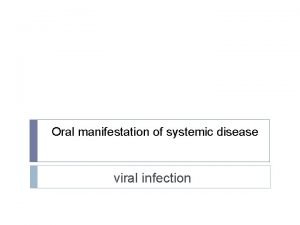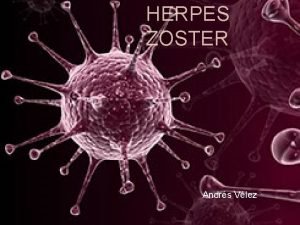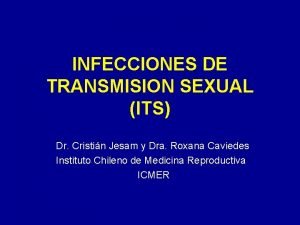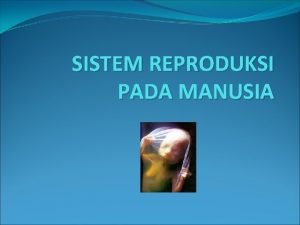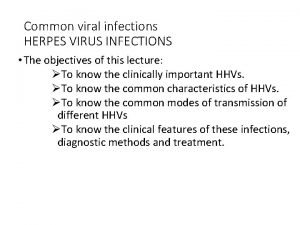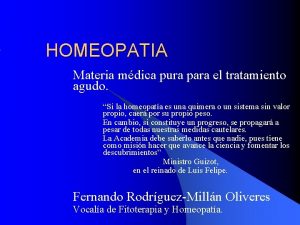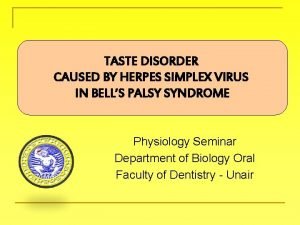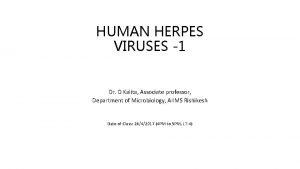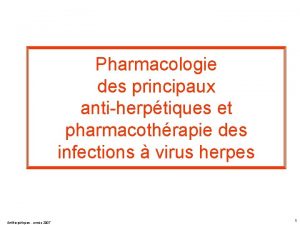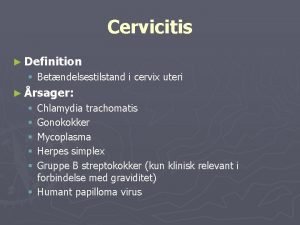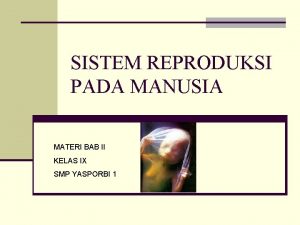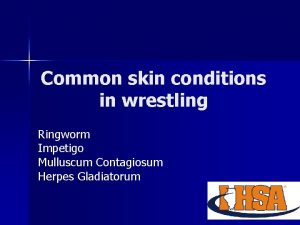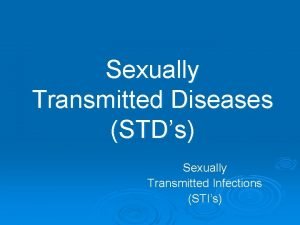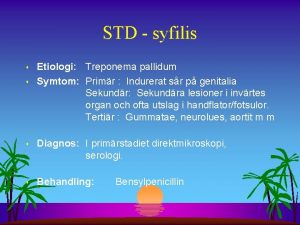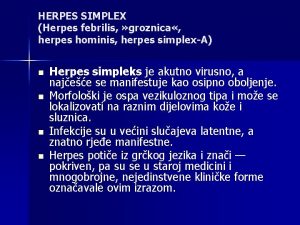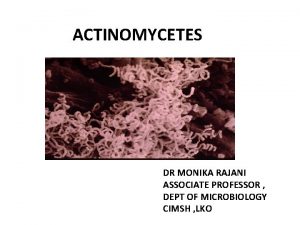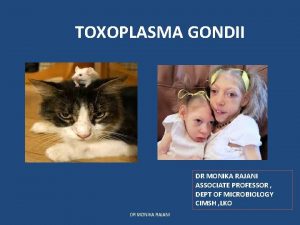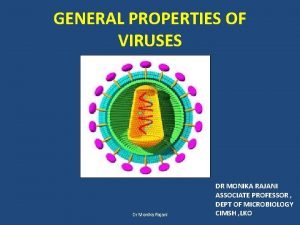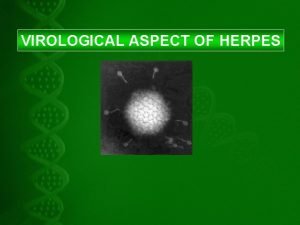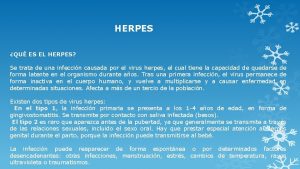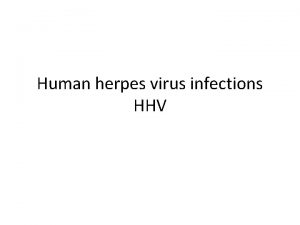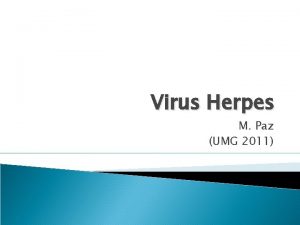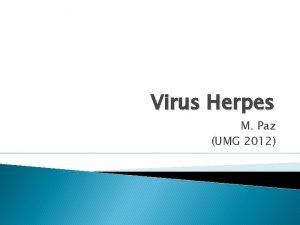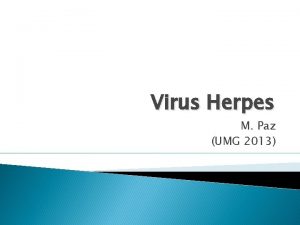HERPES VIRUSESI DR MONIKA RAJANI ASSOCIATE PROFESSOR DEPT






























- Slides: 30

HERPES VIRUSES-I DR MONIKA RAJANI ASSOCIATE PROFESSOR , DEPT OF MICROBIOLOGY CIMSH , LKO

Introduction • Enveloped DNA viruses • Latent infections • Persist indefinitely in host • Periodic reactivation • Some are cancer causing DR MONIKA RAJANI

Morphology • • 200 nm size Icosahedral symmetry Lipid envelope with spikes Tegument: between envelope and capsid Capsid composed of 162 capsomeres Linear double stranded DNA genome Replicate in host cell nucleus. Cowdry type A (Lipschutz) IB Susceptible to fat solvents DR MONIKA RAJANI

Morphology DR MONIKA RAJANI

Classification and nomenclature of Human Herpes Viruses R K VIRUS RRR K DR MONIKA RAJANI

DR MONIKA RAJANI

Subfamilies of Herpesviridae • Alpha herpesviruses: : short replicative cycle (12 -18 hrs) : variable host range : latent infections in sensory ganglia : HSV, VZV • Beta herpesviruses: : Replicate slowly (>24 hrs) : Narrow host range : Cytomegaly : Latent infections of salivary glands : CMV • Gamma herpesviruses: : Narrow host range : Latent infection in lymphoid tissue : EBV DR MONIKA RAJANI

HERPES SIMPLEX VIRUS DR MONIKA RAJANI

Introduction • HSV occures naturally only in humans • Types: 1 -HSV type I- mouth lesions : direct close contact- skin, saliva, respiratory secretions or droplet spread 2 -HSV type II : genital herpes : venereal transmission DR MONIKA RAJANI

Differences between HSV I AND HSV II mouth lesions contact and droplet spread less temperature sensitive less neurovirulent susceptible to antiviral agents • small pocks on CAM • Replicate poorly • • • Genital lesions Veneral More temperature sensitive More neurovirulent Resistant to antiviral agents • Larger pocks • Replicate well in chick embryo fibroblasts DR MONIKA RAJANI

Pathogenicity One of the most common viral infections 60 -90% of adults show AB Humans are the only natural hosts Primary infection acquired in early childhood(2 -5 yrs) • Asymtomatic carriers form the most important source of infection • • DR MONIKA RAJANI

Pathogenicity –mode and route of infection • Close contact(saliva, respiratory droplets, skin )or veneral • Virus enters through defects in skin and mucosa and multiplies locally • Cell to cell spread • Enters nerve fibres and travels intra axonally to ganglia • Ganglia: Trigeminal ganglia(HSV I) and Sacral in HSV II • May remain latent in ganglia and can undergo periodic reactivation • Centrifugal migration –from ganglia to skin • CMI is important in resistance and recovery DR MONIKA RAJANI

defects in skin and mucosa Local multiplication Centrifugal migration Cell to cell spread Enters nerve fibres and travels intra axonally to ganglia-latency , periodic reactivation DR MONIKA RAJANI by sun exposure, cold , stress

Clinical presentation • HSV I: above the waist lesions • HSV II: below the waist lesions • Lesion: thin walled, umblicated vesicles the roof of which breaks down leaving superficial ulcers DR MONIKA RAJANI

Clinical presentation • • Cutaneous infections Mucosal infections Ophthalmic infections CNS infections Visceral infections Genital infections Congenital infections DR MONIKA RAJANI

Clinical presentation • Cutaneous infections: -face, cheeks, chin, around mouth and forehead -buttocks and napkin rash in infants a- Fever blister- viral reactivation in febrile pts b- reactivation with common cold, sun exposure c- Herpetic whitlow: doctors, dentists and nurses d-Eczema herpeticum: generalised eruption due to herpes in children suffering from eczema DR MONIKA RAJANI

Cutaneous lesions NAPKIN RASH ECZEMA HERPETICUM HERPETIC WHITLOW DR MONIKA RAJANI FEVER BLISTERS

Clinical presentation • Mucosal infections: : Buccal mucosa : Gingivostomatitis and pharyngitis : Ulcerations and secondry infections DR MONIKA RAJANI

Clinical presentation • Ophthalmic infections: : HSV is one of the most common cause of corneal blindness : Acute keratoconjunctivitis : Follicular conjunctivitis : Dendritic ulcers : Chorioretinitis : Corneal blindness • Steroids are contraindicated DR MONIKA RAJANI

Clinical presentation • CNS infections: • HSV encephalitis: : One of the most important sporadic viral encephalitis : GBS : Sacral autonomic dysfunction : Transverse myelitis • Visceral infections: : Oesophagitis : Hepatitis : Disseminated infections DR MONIKA RAJANI

Clinical presentation • Genital infections: • Males: urethritis, lesions in penis • Females: cervix , vaginitis and vulval lesions • Rectal and perineal lesions in homosexuals • Both type of herpes may cause genital lesions but HSV II is more frequent and more prone for recurrences DR MONIKA RAJANI

Clinical presentation Congenital infections: MOI: Transplacental-congenital infection -rare Intrapartum- particularily if mother has genital lesions due to HERPES II • Post natal- due to HSV I • clinical picture: : neonatal herpes : disseminated disease : high mortality • • DR MONIKA RAJANI

Neonatal herpes DR MONIKA RAJANI

Laboratory diagnosis • • Specimens: Vesicle fluid Skin swab Saliva Corneal scraping CSF Brain biopsy at autopsy • • • Methods: Microscopy Virus isolation Serology PCR DR MONIKA RAJANI

Microscopy • A- TZANCK SMEAR • Smears are prepared from base of vesicles and stained with 1% aqueous solution of toludine blue O for 15 secs • Positive tzanck smear: - multinucleated giant cells with ground glass chromatin • B-Giemsa stain: -Intranuclear Cowdry Type A Inclusion Bodies • C: Electron microscopy • D: Fluoroscent microscopy: demonstration of antigen DR MONIKA RAJANI

TZANCK SMEAR Multinucleated giant cells with faceted nuclei and homogenously stained ground glass chromatin DR MONIKA RAJANI

virus isolation • Inoculation in mice • CAM in chick embryo • Tissue cultures: : Human diploid fibroblasts : Human amnion : Human embryonic kidney • CPE: well defined foci with heaped up cells with syncitium or giant cell formation. DR MONIKA RAJANI

SEROLOGY • AB detection: CFT : NT : ELISA • PCR: -Demonstration of HSV ds DNA IN CSF DR MONIKA RAJANI

Treatment • • Acyclovir Valaciclovir Famciclovur Idoxyuridine: topical DR MONIKA RAJANI

THANK YOU DR MONIKA RAJANI
 Promotion from associate professor to professor
Promotion from associate professor to professor Rajani shenoy
Rajani shenoy Herpes rugbiorum
Herpes rugbiorum Trivalent vaccin herpes
Trivalent vaccin herpes Aciclovir varicela copii
Aciclovir varicela copii Herpes zoster clasificacion
Herpes zoster clasificacion Zostavax reconstitution
Zostavax reconstitution Its
Its Paraproctio
Paraproctio Herpes genital feminina fotos
Herpes genital feminina fotos Herpes simplex virus 2
Herpes simplex virus 2 Pitiriasis versicolor
Pitiriasis versicolor Herpes genital glande
Herpes genital glande Virus herpes simplex de type 2
Virus herpes simplex de type 2 Herpes simpleksserotipe 2
Herpes simpleksserotipe 2 Herpes zoster
Herpes zoster Site:slidetodoc.com
Site:slidetodoc.com Ledum palustre posologia
Ledum palustre posologia Simplex
Simplex Herpes gravid
Herpes gravid Human herpesvirus 2
Human herpesvirus 2 Herpes simplex virus
Herpes simplex virus Zinazef
Zinazef Imágenes de la gonorrea
Imágenes de la gonorrea Herpes simpleksserotipe 2
Herpes simpleksserotipe 2 Mulluscum contagiosum
Mulluscum contagiosum Genial herpes
Genial herpes Herpes latency
Herpes latency Syntom på klamydia
Syntom på klamydia Herpes genital historia natural de la enfermedad
Herpes genital historia natural de la enfermedad Valaciclovir dosis
Valaciclovir dosis


